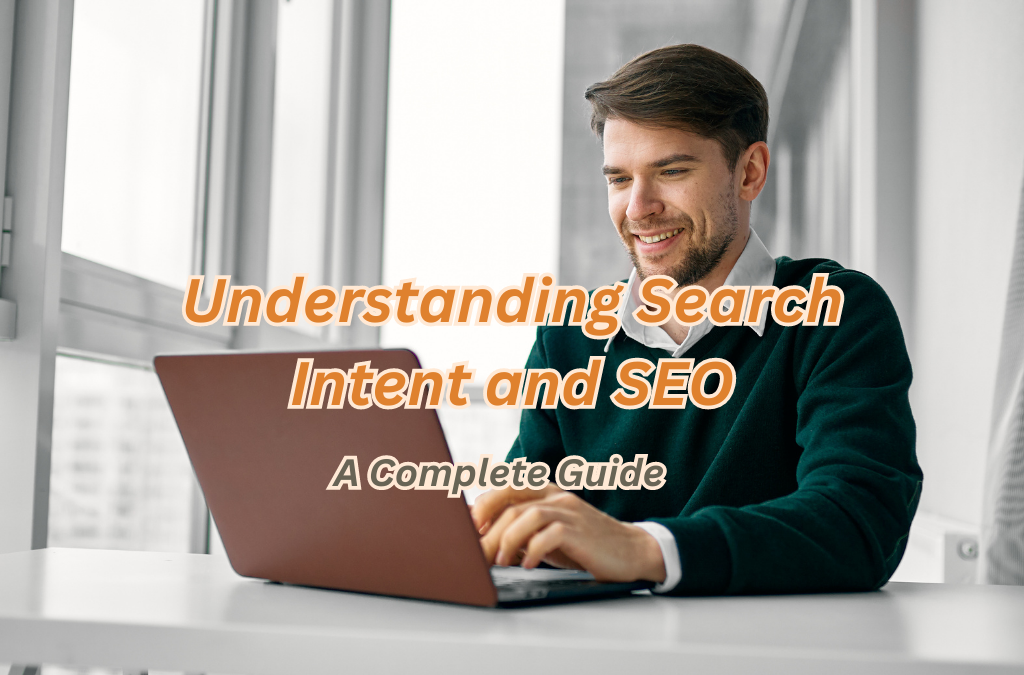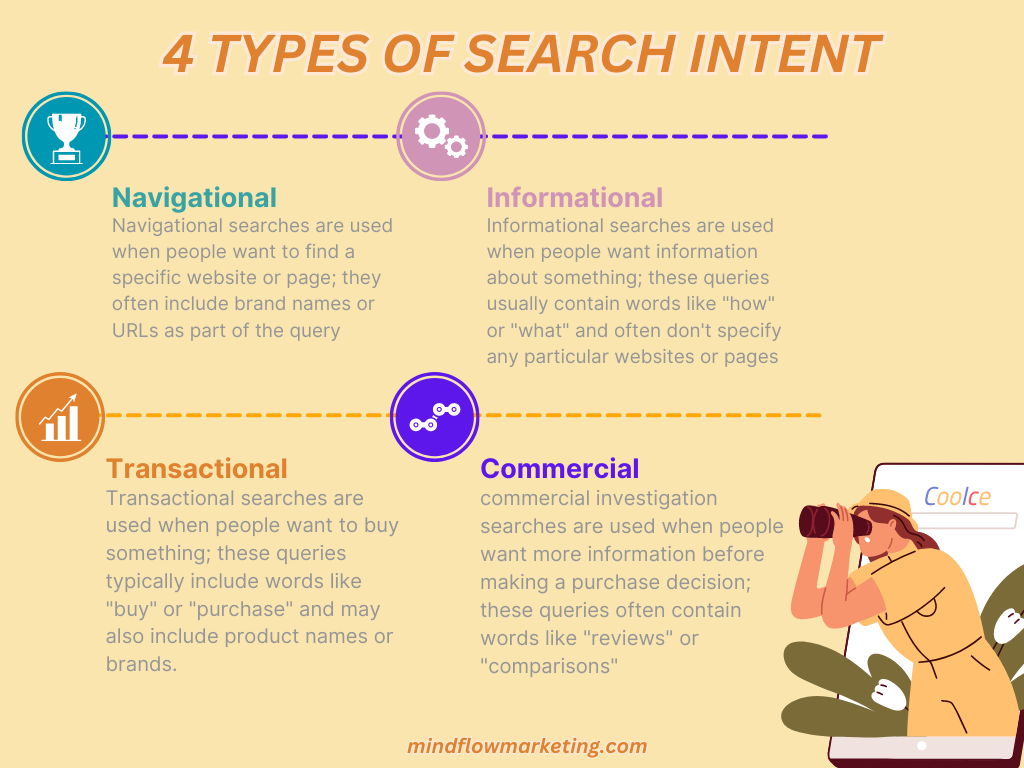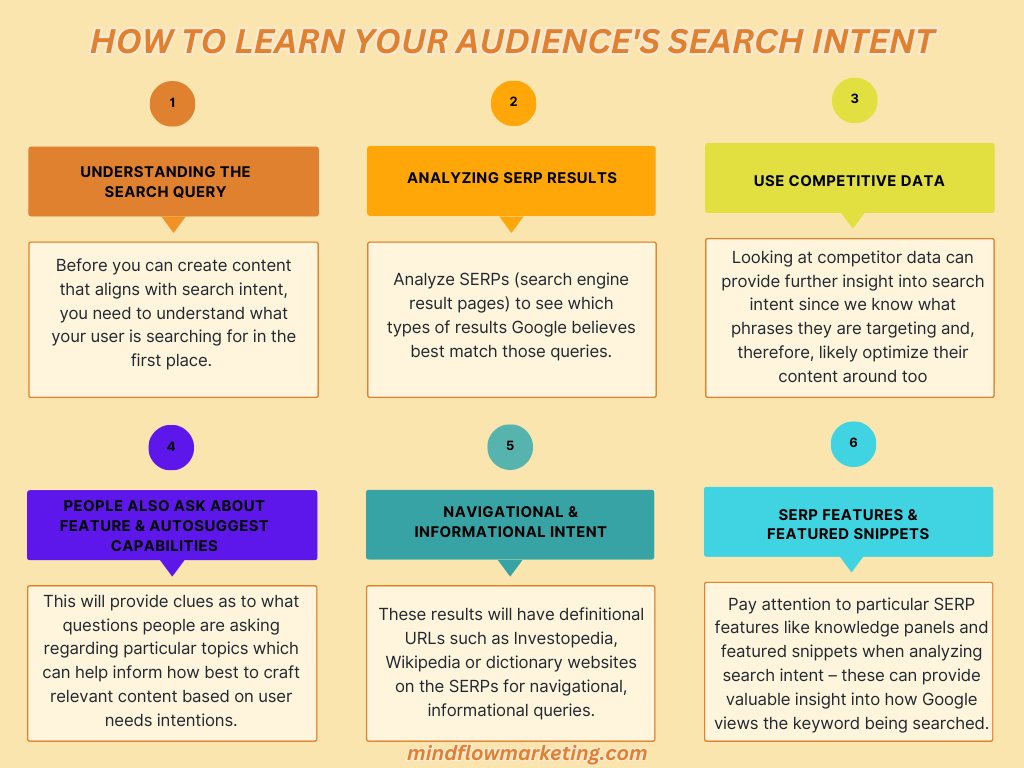Understanding search intent is a crucial part of any successful SEO strategy. This blog post will explore why search intent matters and how to determine it. We’ll dive into the different types of search intent, such as informational, navigational, and transactional intent. By understanding your audience’s search intent and targeting keywords accordingly, you can create content that satisfies their needs and improves your chances of ranking higher on the search results pages.
We’ll also discuss how to conduct keyword research with user intent and use technical SEO to give searchers accurate results. You’ll discover why the commercial goal is essential for businesses looking to drive conversions through organic searches. Finally, we’ll look at real-world examples of content strategies that successfully target specific search intents.
If you aim to increase your website’s visibility on Google Search by crafting content that matches what people are searching for, then keep reading! This post will provide valuable insights into how Google thinks about searcher intent when delivering its results page so that you can choose the right keywords for your site based on what people are looking for.

More Resources :
What is Search Intent ?
Search intent is an essential concept in SEO. It refers to the purpose behind a user’s search query, and it can significantly impact how successful your website is at ranking for that query. Search intent helps you understand why someone might be searching for something, so you can tailor your content to meet their needs. It can be stated that the majority of search queries, accounting for 99%, can be classified into four distinct categories of intent: informational, navigational, commercial, and transactional.
Navigational Searches
Navigational searches are used when people want to find a specific website or page; they often include brand names or URLs as part of the query. Users conduct navigational searches when they know which company or brand they want but need help getting to a specific product page. People typically use phrases like the brand name and a product, such as “Keurig coffee makers at Target.” Search engine results pages (SERPs) for these searches will focus on homepages and product pages from specific websites.
Informational Searches
Informational searches are used when people want information about something; these queries usually contain words like “how” or “what” and often don’t specify any particular websites or pages. The content on such pages must be easy to skim so users can quickly get the information they need. Examples could include queries such as “How do I fix my computer?” or “What is the best type of camera?”
Transactional Searches
Transactional searches are used when people want to buy something; these queries typically include words like “buy” or “purchase” and may also include product names or brands. They have commercial intent; people use phrases like “price” or “sale” because they’re ready to buy something specific. For example, someone may search “buy Nike shoes online.” SERPs for transactional searches tend to feature shopping sites, e-commerce stores, and other retailers offering products related to their query.
Commercial Investigation
Finally, commercial investigation searches are used when people want more information before making a purchase decision; these queries often contain words like “reviews” or “comparisons” and may also include product names or brands.

How SEO and Search Intent Are Linked
Understanding search intent is critical if you want your website to rank well in organic search results because Google wants its users to get what they’re looking for quickly and easily – providing relevant content based on their query type.
For example, suppose someone performs an informational search such as “What is SEO?”. In that case, Google will likely show them web pages containing detailed explanations of what SEO stands for rather than pages selling SEO services – even though those last pages might use keywords related to the query itself!
As such, you must create content explicitly tailored towards each type of query so that Google knows precisely what kind of answer its users should expect from visiting your site. Moreover, Google’s mission is quite clear as it aims to make the world’s information easily accessible and useful by organizing it.
Why Knowing the Search Intent is Important
Search engine optimization (SEO) is an ever-evolving process that requires a deep understanding of the user’s intent. Knowing what users are looking for when they search can help you create content and optimize your website to ensure it appears in the top results on search engines.
Understanding the search intent behind each query is essential for SEO success, as it helps you determine which keywords to target and how best to structure your content. When optimizing a website, it’s necessary to consider both short-tail and long-tail keywords. Short-tail keywords are more general terms with higher search volumes and greater competition. In comparison, long-tail keywords are more specific phrases with lower search volumes but less competition.
To maximize visibility in organic searches, you should use both types of keywords strategically throughout your content; however, knowing the intent behind each keyword will help you prioritize them accordingly. It’s also essential to consider user behaviour when optimizing a website for SEO purposes; this includes analyzing clickthrough rates (CTRs), bounce rates, page views per session and time spent on site metrics from Google Analytics or other analytics tools.
By studying these metrics closely, you can gain insight into how users interact with your pages and better understand their needs so that you can tailor content accordingly and improve overall performance over time.
Knowing the searcher’s intent also allows marketers to craft compelling titles and meta descriptions for their web pages that will attract clicks from organic searches – “click bait” or “click bait” tactics – which ultimately leads to increased traffic on those pages done correctly. Additionally, understanding why people are searching specific terms enables marketers to identify potential topics they may not have considered before that could potentially be used as blog post ideas or even new product service offerings down the line based on consumer demand signals seen through online searches!
Finally, having an accurate picture of what users want when they type in queries related to your business gives you an edge over competitors who don’t take this approach – allowing companies like yours to stay ahead of trends by being able to provide relevant information quickly & efficiently compared others who might still be playing catch up due lack knowledge about user intentions during their research phase!
How to Optimize Your Content for Navigational Search
Navigational search intent is users’ query for a specific website or page. Optimizing your content for this type of search intent is essential to rank higher in the SERPs (Search Engine Results Pages).
Here are some tips on how you can do this:
When creating content, use keywords strategically throughout the text to make it easier for search engines to find and index your page. Ensure you include relevant keywords related to the topic and variations of those words, such as synonyms and plurals. That will help ensure your content is more likely to appear in navigational searches.
Creating unique titles and meta descriptions helps increase visibility in navigational searches by making it easier for searchers to identify which result best matches their query. Additionally, adding targeted keywords into these elements can improve rankings significantly since they act like mini-advertisements for your pages when they appear in SERPs.
Using structured data markup allows search engines better understand what information is contained within each web page and how it relates to other pages on the site – helping them determine which results should be displayed first during navigational queries. This markup language can also provide additional context about a particular piece of content, allowing users an even better chance at finding what they’re looking for quickly and easily without having to sift through irrelevant results first.
Optimized URLs make it much easier for humans and bots alike to recognize what kind of information each page contains before clicking through – improving clickthrough rates from SERPs significantly while boosting SEO performance due to increased engagement with visitors who land on those pages directly from organic searches.
Finally, monitoring popular search queries can give you valuable insight into what people are searching most often for related topics allowing you to adjust your strategy accordingly to remain competitive against other websites vying for top spots during navigational queries.
How to Optimize Content for Informational Intent
Optimizing for informational intent is essential in SEO, as it helps users find the answers they want. To optimize for this type of search intent, you need to create content that provides comprehensive and accurate information about a particular topic or subject matter.
When creating content, focus on using relevant keywords throughout the text. That will help improve your chances of appearing in search engine results pages (SERPs) when users enter related queries into Google or other search engines. Ensure your material is comprehensive enough to answer readers’ questions, so they don’t need to seek additional information.
To increase your chances of ranking well with informational intent-based searches, use headings and subheadings within your content to break up large chunks of text and make it easier for readers to skim through quickly. Also, consider including visuals such as images or videos which can help illustrate points more effectively than words alone can do.
Attention to page loading speed: visitors may click away if it takes too long; optimizing with caching plugins and compressing images can help improve user experience. If a page takes less time to open, visitors may only abandon the site after bringing in your content. Use caching plugins where possible and compress images before uploading them onto your site; these steps should help reduce loading times significantly and provide an overall better user experience for those who visit your website from organic searches based on informational intent.
How to Optimize Content for Transactional & Commercial Investigation Intent
Optimizing for transactional and commercial investigation intent is essential in SEO. It involves targeting users looking to purchase something or research products/services before deciding. Follow the steps to optimize your content accordingly:
To ensure your content appeals to this type of user, you should focus on creating product pages with detailed descriptions and optimizing product images and videos with relevant keywords and metadata tags. Providing enough information about the item is beneficial so potential customers can easily find what they’re looking for without having to search too much. That means including features like high-quality photos, accurate pricing information, precise delivery details, etc., all of which should be optimized using relevant keywords and metadata tags. Additionally, it’s essential to include reviews from other customers since these can help build trust in potential buyers.
Product videos are also an effective way of optimizing for transactional intent because they provide a more visual representation of the item sold than text alone can. When creating video content related to your products or services, optimize them by including relevant keywords in titles and descriptions and adding captions if possible (which will help those with difficulty hearing).
Use appropriate thumbnail images when uploading videos so that viewers know what they’re clicking on right away – this will ensure higher clickthrough rates which could lead to increased sales conversions over time.
Finally, remember social media platforms when optimizing for transactional intent. Sharing links to product pages or promotional offers on sites like Facebook or Twitter can be a great way to get more eyes on your business offerings quickly. Every post needs its own set of unique metadata and should also include proper hashtags associated with it; this helps create visibility across different networks while allowing users searching for specific items easier access.
How to Learn Your Audience’s Search Intent
You can follow the given measures to understand the search intent of your audience:

Before you can create content that aligns with search intent, you need to understand what your user is searching for in the first place. That requires thoroughly analyzing each keyword or phrase and understanding its context within a more powerful query. Start by looking at modifiers like location, product type, or brand names used in questions, as these can be critical indicators of intent. Additionally, it’s essential to consider how different users may interpret a query differently based on their individual experiences and background knowledge—this will help ensure that your content meets all expectations regardless of who’s searching for it.
Once you know what people are searching for when they land on your page, it’s time to analyze SERPs (search engine result pages) to see which types of results Google believes best match those queries. Look closely at organic and paid results; if several ads are listed above organic listings, this could indicate high commercial intent. However, if most listings are informational, this could suggest a more heightened navigational sense instead. It would help if you also took note of any featured snippets or other rich media, such as videos or images which appear alongside standard web pages, as these often signal specific user intents too.
Looking at competitor data can provide further insight into search intent since we know what phrases they are targeting and, therefore, likely optimize their content around too. If possible, try using tools such as Ahrefs Site Explorer to get an overview of competitors’ backlink profiles so you can determine which topic keywords they’re covering in-depth and where gaps might exist in terms of coverage from them compared to yourself – this way, you’ll be able to create unique pieces that stand out from the crowd but still meet users’ needs.
Utilize features such as Google’s “People Also Ask” the quality or its autosuggest capabilities, which appear at the bottom of search results pages or when entering specific queries into the search bar respectively; this will provide clues as to what questions people are asking regarding particular topics which can help inform how best to craft relevant content based on user needs intentions.
These types of searches are more accessible to identify than commercial or transactional intents since they’re more straightforward and typically don’t involve any purchase decision. These results will have definitional URLs such as Investopedia, Wikipedia or dictionary websites on the SERPs for navigational, informational queries.
Pay attention to particular SERP features like knowledge panels and featured snippets when analyzing search intent – these can provide valuable insight into how Google views the keyword being searched. For example, suppose there’s a knowledge panel associated with the query. In that case, it may indicate that Google sees it as informational rather than commercial. In contrast, if there’s a featured snippet, it could suggest that users want quick answers without having to click through multiple pages (i.e., transactional).
Frequently Asked Questions
Conclusion
Search intent is an essential factor for SEO success. By understanding the types of search intent and how to optimize for each, you can improve your rankings and reach more potential customers. Identifying search intent helps marketers create content that meets user needs, drives conversions, and improves visibility in SERPs.
Utilizing a combination of keyword research tools as well as analytics data will help you identify trends in terms of user behaviour so that you can tailor your content to meet their expectations – ultimately resulting in higher organic traffic from users looking for what you have to offer with regards to “search intent and SEO”.